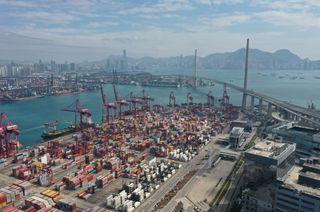The Trump Administration has shown a surprising amount of clarity on its intentions for trade policy in the Asia-Pacific. During the presidential campaign, Trump outlined a series of trade initiatives which, in comparison to other areas, were clear, specific and internally consistent.
Unfortunately, the trade policies which Trump has promised are highly adverse. They threaten many Australian economic interests — in particular, the Trans-Pacific Partnership and good economic relations with China — while narrowing future trade policy options. Significant changes in Australia’s trade diplomacy, including a rapid reorientation towards Asia-led trade initiatives, will need to occur if Australia is to minimise the damage to its economy and its place in the region.
Trump’s trade agenda — some clarity, at least
The Trump Administration’s trade agenda breaks with several decades of US orthodoxy by adopting an avowedly protectionist stance. During the election campaign, Trump committed to:
- Withdraw from the Trans-Pacific Partnership (TPP) on the first day in office1
- Renegotiate the North American Free Trade Agreement (NAFTA)2
- Sign bilateral free trade agreements (FTAs) only when these can deliver trade surpluses to the US3
- Designate China a ‘currency manipulator’ within the first 100 days in office, to enable the imposition of protective duties against Chinese imports4
Commitment to this platform was immediately confirmed, with Trump using his first executive order to initiate US withdrawal from the TPP ratification process.5 US withdrawal terminally compromises the deal in its present form. The TPP’s entry-into-force provisions required at least six members — accounting for 85 per cent of the GDP of the bloc — to ratify.6 As the United States accounts for 65 per cent of the TPP’s economic size,7 its withdrawal makes it numerically impossible for the agreement to enter into force.
The immediate effect of the collapse of the TPP is to throw US economic leadership in the Asia-Pacific into question. The TPP was a controversial agreement. Its regulatory provisions regarding investor-state dispute settlement, pharmaceuticals and intellectual property were widely criticised abroad as giving too much rather than too little favour to US economic interests.8 Yet many Asian governments accepted the heavy adjustment costs the TPP implied, since it would offer preferential access to the large US industrial and consumer markets. These trade-offs were particularly significant for Vietnam (which made major compromises to its labour regime) and Japan (which agreed to highly-sensitive reforms of its agricultural tariffs). The last-minute US withdrawal has left its partners feeling abandoned and resentful. The Trump Administration will now be viewed as a wholly unreliable economic partner.
Threats against NAFTA will not do much good for US interests in its own backyard either. During the presidential campaign, Trump frequently labelled it the “worst deal ever”, and promised to renegotiate the deal. The Canadian prime minister has agreed to dialogue on NAFTA;9 while the Mexican president has agreed to ‘discuss but not renegotiate’ the treaty.10 Within days of the inauguration, the head of Trump’s strategic and policy forum met with the Canadian prime minister and cabinet to discuss NAFTA renegotiation.11 But as former Deputy USTR Wendy Cutler has pointed out, in any renegotiation process Canada and Mexico would rightly demand concessions of their own in turn.12 Compounding matters, the administration has threatened to impose a 20 per cent tariff on Mexican imports if Mexico refuses to contribute to the construction of a promised border wall between the countries.13
Perhaps most worrying have been trade policy threats directed at China. During the campaign, Trump made much of the fact that China accounted for half the US trade deficit, and promised to officially designate the country a ‘currency manipulator’ within his first 100 days in office.14 This designation sets the trigger for the imposition of retaliatory tariffs — potentially as high as 45 per cent — against Chinese imports. However, any such move would likely be in breach of WTO rules, as China is currently over- rather than under-valuing the RMB. It may also invite immediate retaliation from China, in the form of tit-for-tat tariffs on US exports. Several analysts have expressed concern that this could potentially spiral into a bilateral trade war.15
The collapse of the Trans-Pacific Partnership means the United States has relinquished what little influence it had over the future shape of the regional trade system.
Overall, Trump’s trade policies will thoroughly delegitimise the US leadership in global and regional economic diplomacy. Long-standing partners will be harmed by moves against the TPP and NAFTA, whose exporters stand to lose preferential access to the US market. Trade relations with China may become openly hostile, causing havoc both for industries that span the world’s two largest economies and third parties that trade with them. The collapse of the TPP means the United States has relinquished what little influence it had over the future shape of the regional trade system.
Is a trade war with China realistic?
A possible trade war between the United States and China is often considered the single biggest threat of the Trump Administration to Australia.16 Yet it is not as likely as many believe.
Despite fiery rhetoric during the campaign, Trump’s official trade platform17 is surprisingly modest on this issue. It only promises to: (a) instruct the Treasury Secretary to label China a currency manipulator; and (b) instruct the USTR to bring trade cases against alleged Chinese trade subsidies.
The latter is a relatively uncontroversial policy, as the USTR already brings many trade cases against China via the WTO’s dispute settlement mechanism. During the Obama Administration, the USTR launched 21 WTO enforcement complaints — 12 of which were directed at China — and prevailed in every case decided thus far.18 It is therefore the former commitment — to designate China a currency manipulator — that potentially threatens trade war.
To be sure, applying this designation does not commit the United States to retaliatory action.19 As per the Omnibus Trade and Competitiveness Act of 1988, doing so only requires the Treasury to “initiate negotiations” with China over its exchange rate policy. But as monetary policy interventions by the People’s Bank of China in recent years have applied upward pressure on the RMB, it is unclear what further actions the United States could realistically demand China undertake. Only once such bilateral negotiations fail could trade remedies be applied. The application of remedies is a distinct second step that follows the currency manipulator designation, and remains at the administration’s future discretion.
Doing so would be hugely detrimental to the US economy. It would impose massive costs on US businesses, stoke domestic inflation, invite tit-for-tat retaliation by China, and would likely be found to be in breach of WTO rules.20 Nor would it do much for job creation,21 as the selective imposition of tariffs against China cannot create jobs in globalised industries where the United States lacks current industrial capacity, let alone comparative advantages.
These considerations mean that Trump’s trade threats against China are likely “more political than practical”.22 Rather than a genuine policy commitment, they simply reflect an instrumental electoral strategy designed to appeal to protectionist constituents at home. Designed with ‘room to move’, the administration can progressively back away once in office if it wishes to avoid the economic costs that would follow. Applying the ‘currency manipulator’ certainly sends political signals to China, but does not fully commit the two to a mutually destructive trade war yet.
Australia’s limited options: RCEP, regional economic diplomacy, and China
Australia now finds its trade policy options severely circumscribed. In part, this is because the question remains as to how the Trump Administration will execute its agenda. While its trade policy commitments are clear and consistent, they are also politically risky and economically destructive. Some of the more dramatic elements — such as a fractious renegotiation of NAFTA, or trade war with China — will hopefully be moderated. However, the costs to Australia also reflect the fact that Trump is taking several moves in Asia that directly threaten Australia’s trade interests.
The collapse of the TPP denies Australia its number one trade policy priority — an open, multilateral and ambitious reinvigoration of the regional trade architecture. The China-backed Regional Comprehensive Economic Partnership (RCEP) agreement is now being viewed as a credible alternative. RCEP is similar to the TPP in that it promises a new ‘mega-regional’ trade agreement for Asia. However, it is far from a perfect substitute. Its reform ambitions are considerably lower, eschewing most of the TPP’s regulatory provisions in favour of a focus on the traditional trade matters of market access and tariffs. It also has a radically different membership model, achieving full coverage of ‘Asia’ — particularly, China, India and Indonesia — while excluding ‘Pacific’ economies such as the United States.23
The Australian government is yet to recalibrate its Asian trade strategy in the wake of the Trump shock. It has frequently reiterated its support for the TPP since the election;24 and following the official US withdrawal in January the trade minister announced a strategy of ‘reconstituting’ the TPP without US involvement.25 However, this is not politically realistic. The bargain underlying the TPP involved Asian governments undertaking US-demanded regulatory reforms in exchange for preferential access to the large US market. In the absence of the United States, Asian governments will see no benefit in persisting with the agreement. Indeed, the Japanese government has said the TPP is “meaningless” without the United States, and will not seek to revive the deal with a different membership or ratification requirements.26
With the Trans-Pacific Partnership — both in its current and potentially revised forms — now unviable, Australia needs a new trade policy strategy. Active participation in the ongoing Regional Comprehensive Economic Partnership negotiations is a prudent option.
With the TPP — both in its current and potentially revised forms — now unviable, Australia needs a new trade policy strategy. Active participation in the ongoing RCEP negotiations is a prudent option. To be sure, RCEP is likely to offer much less for Australia than the TPP, particularly in terms of services and agriculture.27 However, the fact that it will contribute to trade liberalisation at all makes it a defensible ‘second best’ strategy, particularly given that it offers a multilateral approach covering many of Australia’s key export markets. Australian trade negotiations should now push for the most ambitious text possible as RCEP talks move towards completion in 2017. A key goal is securing an open accession mechanism, which would allow additional countries (potentially including a post-Trump United States) to join in the future.
Trump has signalled a renewed interest in bilateral trade agreements,28 and with the TPP collapse many regional governments are likely to make similar moves. Some have suggested this is an appropriate way forward for Australia.29 However, Australia already has bilateral agreements with all its key trade partners, with the exceptions of Indonesia and India where FTA negotiations are currently underway. Simply ‘doing more bilaterals’ is unlikely to deliver meaningful gains, as these will be with relatively small trade partners and thus yield progressively diminishing returns. New mechanisms for advancing liberalisation with Australia’s existing FTA partners — such as sectoral dialogues for key industries, trade-linked economic and technical cooperation, and intensified economic diplomacy — need to be explored instead.
Australia also needs to hedge against the unlikely (but potentially catastrophic) event of Trump following through on trade threats against China. Were a trade war between the United States and China to occur, Australia may find itself in the invidious position of being asked to take sides between its first and third most important trade partners. Australian diplomats will need to find ways to reinforce the bilateral economic relationship with China, in order to counteract the damage of deteriorating Sino-US ties. Active contributions to the Asian Infrastructure Investment Bank’s work, alongside support for Chinese initiatives in multilateral economic fora (such as the G20, APEC and the EAS) would go some way to manage these risks.
None of these trade policy options are particularly attractive for Australia. As a small open economy, the country would be much better served by high-quality multilateral liberalisation (i.e. the TPP) and trust-based relations between the region’s two major economic powers. But with the regional trade environment already deteriorating, Australian trade diplomacy needs to move beyond the TPP and embrace alternate initiatives focused on Asian partners. If current trade strategies are not adjusted, the Australian economy will find itself the victim of a Trump-induced trade policy shock.





